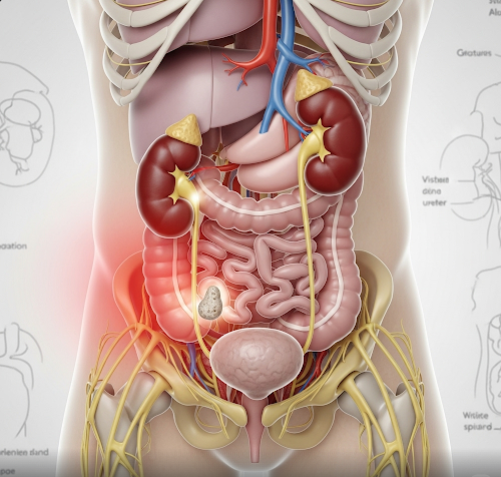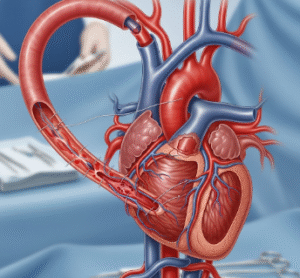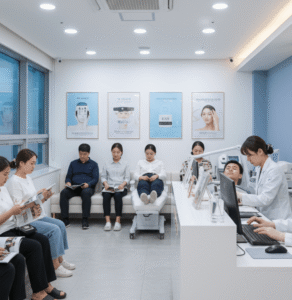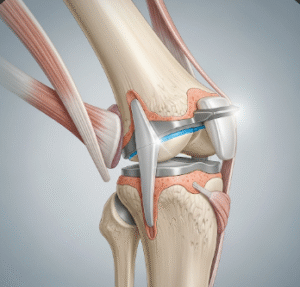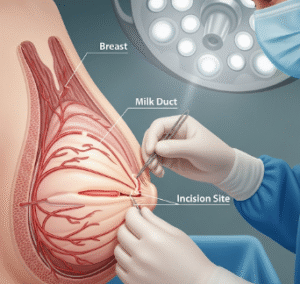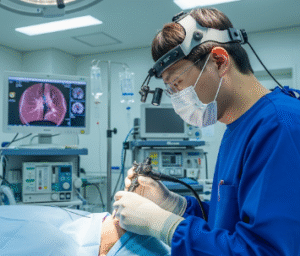Overview
Renal colic refers to the severe, sharp pain caused by kidney stones obstructing the urinary tract. It is a common urological emergency characterized by sudden onset of intense flank pain that may radiate to the groin. In Korea, renal colic is diagnosed and managed promptly using advanced imaging, pain management, and minimally invasive stone removal techniques.
What is Renal Colic?
Renal colic occurs when a kidney stone blocks the flow of urine, causing the ureter to spasm and resulting in intense, cramping pain. The pain usually starts in the flank and can move toward the lower abdomen and groin as the stone travels.
Symptoms
- Sudden, severe flank pain often described as sharp, cramping, or wave-like
- Pain radiating to the lower abdomen, groin, or genitals
- Nausea and vomiting
- Blood in urine (hematuria)
- Frequent urination or urgency
- Possible fever if infection develops
Causes
- Formation of kidney stones due to high levels of calcium, oxalate, or uric acid
- Dehydration and low urine volume
- Dietary factors and metabolic disorders
- Urinary tract abnormalities or infections
Risk Factors
- Family history of kidney stones
- Dehydration or low fluid intake
- High protein, salt, or sugar diet
- Obesity and sedentary lifestyle
- Certain medical conditions such as gout or hyperparathyroidism
Complications
- Urinary tract infections
- Kidney damage due to prolonged obstruction
- Recurrent stone formation
- Severe infection (urosepsis) if untreated
Prevention
- Increase fluid intake to maintain urine output
- Dietary modifications to reduce stone-forming substances
- Medications to control metabolic causes if indicated
- Regular monitoring for recurrent stone formers
Treatment Options in Korea
Diagnosis
- Ultrasound as first-line imaging
- Non-contrast CT scan for precise stone detection and sizing
- Urinalysis and blood tests to evaluate infection and kidney function
Medical Treatments
- Pain management with NSAIDs and opioids if needed
- Medical expulsive therapy using alpha-blockers to facilitate stone passage
- Hydration and anti-nausea medications
Interventional & Surgical Treatments
- Extracorporeal shock wave lithotripsy (ESWL) to break stones non-invasively
- Ureteroscopy with laser lithotripsy for stones in ureter or kidney
- Percutaneous nephrolithotomy for large or complex stones
- Minimally invasive techniques widely practiced in Korea with high success rates
Advanced Therapies
- Use of flexible ureteroscopes and high-power lasers
- Integration of imaging guidance for precise stone removal
Rehabilitation and Support
- Follow-up imaging to ensure stone clearance
- Lifestyle counseling to prevent recurrence
- Management of any residual symptoms or infections
Top Hospitals or Clinics in Korea for Renal Colic
- Seoul National University Hospital – Expertise in urology and stone management
- Asan Medical Center – Advanced endourology and minimally invasive stone removal
- Samsung Medical Center – Specialized in laser lithotripsy and ESWL
- Yonsei Severance Hospital – Comprehensive kidney stone treatment and prevention
- Korea University Anam Hospital – Leading center for urological disorders

